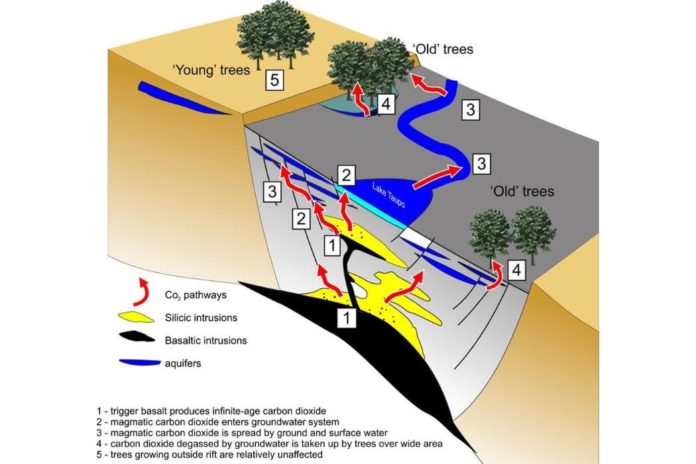Giant volcanic eruptions are captivating events. These massive events can have a global impact and the idea of a massive ash plume towering 30 kilometers or more over the landscape is an awe-inspiring notion.
The ~186 A.D. eruption of Taupo in New Zealand has been considered one of the largest eruptions during the last 10,000 years. It produced over 50 cubic kilometers of volcanic ash and debris (tephra) and pyroclastic flows that destroyed over 20,000 square kilometers of the North Island of New Zealand.
A new study by the University of Canterbury suggests that some volcanic eruptions, including the most recent large Taupo eruption in New Zealand, may be lying about their age. The study shows that carbon dioxide gas emitted from deep below volcanoes can be redistributed by groundwater systems and bias radiocarbon dates of prehistoric eruptions.
The investigation presents proof that the Taupo eruption happened between 40 years and 200 years after the fact that the present date of 232 CE. Dates for eruptions of volcanoes somewhere else may likewise be excessively old. In uncovering these explosive volcanic lies, the UC specialists investigate how volcanoes can lie about their age, and what it implies for the world.
Accurate dating of prehistoric eruptions is important as it allows them to be correlated with other records, such as historical and climatic events, allowing a better understanding of the linkages between volcanism and the natural and cultural environment.
The current favored technique for ejection dating, “wiggle match dating,” relates successions of dates from tree rings to a record of regular variation in the amount of carbon-14 in the environment through time. On a basic level this can be utilized to pinpoint when an eruption killed the tree. Be that as it may, it isn’t substantial if gas from the fountain of liquid magma is influencing the tree’s form of the wiggle.
The scientists reanalyzed in excess of 40 radiocarbon dates on plant stays from underneath or more the volcanic ash layer from the Taupo emission in the First Millennium. They found that the most seasoned dates were nearest to the volcano vent, and dates turned out to be continuously more youthful the more remote away they were. The geographic example recommends that carbon in plants and plant stays; for example, peat inside 60km from the vent gives misleadingly old dates.
Integrating information from biology and volcanology, the team found that the ratio of carbon-13 to carbon-12 (the two stable isotopes of carbon) in the radiocarbon date samples and in the water of Lake Taupo and the Waikato River are consistent with volcanic carbon dioxide injected into the groundwater from a developing magma body. This carbon dioxide leaks from the groundwater into the atmosphere and is taken up by photosynthesizing plants. The carbon in that volcanic carbon dioxide lacks carbon-14 and so dilutes the carbon-14 obtained from the atmosphere, making the radiocarbon date measured on the wood appear older than it should be.
The tree wood records where the carbon was coming from over decades and centuries and provides a real timescale for the changes in the rings.
Moreover, the study suggests that the likelihood of anticipating future eruptions. The specialists demonstrated that the radiocarbon dates and isotope data, which support the by and by acknowledged squirm coordinate age for the eruption, plateaued. Effectively, the age of the outer ring of the dated tree, which was knocked down and killed by the eruption, had stopped to pursue the tree’s growth a very long while before the eruption.
UC alumnus Dr Brendan Duffy, a lecturer in Applied Geoscience at the University of Melbourne said, “radiocarbon wiggle match date series for other major eruptions, including at Rabaul in Papua New Guinea and Baitoushan on the North Korean border with China, showed similar patterns.”
Apart from supporting the Taupo study, and indicating that there may also be problems with the dates of these volcanic eruptions, the similarities imply that measurements of carbon isotopes in 200-300 annual rings can track changes in the carbon source used by trees growing near a volcano, providing a potential method of forecasting future large eruptions.
UC Adjunct Professor Richard Holdaway identified the relationships between radiocarbon ages, carbon isotopic values and eruptions.
“We found that long-term monitoring of the carbon isotopes in trees growing near a volcano can show trends that reveal the state of the magma body beneath. These may potentially allow long-term forecasting of major eruptions. What people will do with a forecast for an event that may occur several decades later is anyone’s guess,” he says.
“The situation is not unlike that involved with forecasts of future movement on major faults such as the San Andreas and New Zealand alpine faults. The difference is that for an eruption, continued monitoring can refine the forecast, whereas predictions of fault movement are statistical, based on estimates of how far fault movements are apart in time and when the fault last moved. And, of course, the eruption of super-volcanoes like Yellowstone and Taupo would have global effects that would dwarf the effects of almost any earthquake.”
Dr. Kennedy adds: “If the Taupo date is wrong, then our current understanding of any association between large eruptions and changes in Earth’s climate may need to be re-examined.”
The study is published in the journal Nature Communications.
